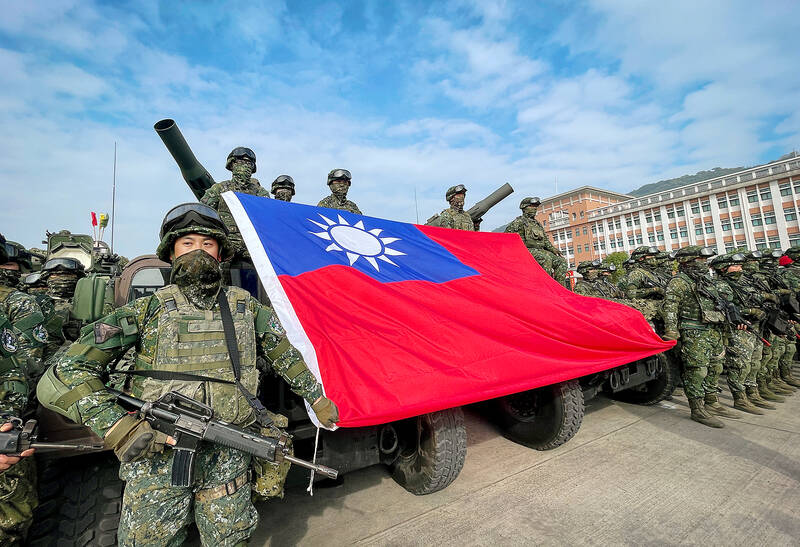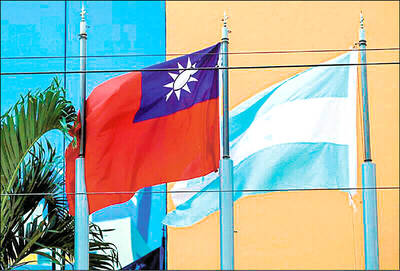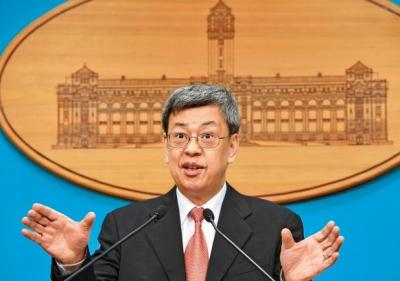A war game by a Japanese think tank simulating a Chinese invasion of Taiwan resulted in a defeat for Beijing, with ghastly losses of troops and equipment on both sides, the Nikkei Asia magazine reported yesterday.
The tabletop simulation conducted by the Sasakawa Peace Foundation envisioned the Chinese People’s Liberation Army (PLA) launching an amphibious attack on Taiwan in 2026 against the combined forces of Taiwan, Japan and the US, it said.
The exercise was conducted over four days through Jan. 21, with close to 30 participants, including retired Japanese military officers, and academics and researchers from the US and Japan, it said.

Photo: CNA
The Chinese offensive failed to seize Taiwan after a two-week struggle that cost the PLA 156 warships, including two aircraft carriers, 168 fighter jets, 48 transport aircraft and more than 40,000 soldiers killed or wounded, it said.
The victory came at a heavy price for the defending forces, who lost more than 26,000 military personnel, scores of warships and hundreds of aircraft, the report said.
The exercise had a PLA command center for the Taiwan front that was capable of deploying all of China’s aircraft, submarines and surface combat capabilities, it said.
In response, the US sent two nuclear-powered aircraft carriers and advanced stealth fighter jets to the theater, while Tokyo permitted the US to operate from Japan Self-Defense Forces bases and civilian airports on Okinawa and Kyushu after invoking a state of emergency, the report said.
After detecting Chinese plans to attack its military bases being used by the US, Japan designated the conflict as an existential threat, prompting Japanese F-35s and warships to join the US in launching missile attacks against the PLA, it said.
The US and Japanese forces overwhelmed China’s, cutting the PLA’s supply lines before seizing control of the airspace over Taiwan in a decisive blow that terminated the battle, it said.
The exercise ended with casualties among Taiwan’s armed forces totaling 13,000 killed, wounded or captured, while 18 warships and 200 warplanes were lost.
The US military’s casualties tallied at 10,700 service members, 19 ships and 400 warplanes, while the Japan Self-Defense Forces lost 15 ships, 144 fighter jets and 2,500 military personnel. Hundreds to 1,000 civilians were killed or wounded by Chinese strikes in Japan, the exercise showed.
Last year, the US-based Center for Strategic and International Studies (CSIS) conducted a series of tabletop exercises on a Taiwan Strait conflict, which found that China was defeated in a majority of the 24 simulations, but at a similarly high cost to the forces of Taiwan, the US and Japan, the report said.
The Sasakawa and CSIS games were predicated on current capabilities and arsenals projected for 2026, so outcomes would differ if the PLA significantly improves its capabilities, it said.
China is rapidly building up its military and some experts believe Beijing is poised to swing the balance of the west Pacific to its favor within two years, the report said, adding that China is also swiftly expanding its nuclear arsenal.
“We must make every possible preparation for substantial losses while we still can,” Tsuneo Watanabe, a senior research fellow at the foundation, was quoted as saying.

Taiwan would welcome the return of Honduras as a diplomatic ally if its next president decides to make such a move, Minister of Foreign Affairs Lin Chia-lung (林佳龍) said yesterday. “Of course, we would welcome Honduras if they want to restore diplomatic ties with Taiwan after their elections,” Lin said at a meeting of the legislature’s Foreign Affairs and National Defense Committee, when asked to comment on statements made by two of the three Honduran presidential candidates during the presidential campaign in the Central American country. Taiwan is paying close attention to the region as a whole in the wake of a

President William Lai (賴清德) has appointed former vice president Chen Chien-jen (陳建仁) to attend the late Pope Francis’ funeral at the Vatican City on Saturday on his behalf, the Ministry of Foreign Affairs said today. The Holy See announced Francis’ funeral would take place on Saturday at 10am in St Peter’s Square. The ministry expressed condolences over Francis’ passing and said that Chen would represent Taiwan at the funeral and offer condolences in person. Taiwan and the Vatican have a long-standing and close diplomatic relationship, the ministry said. Both sides agreed to have Chen represent Taiwan at the funeral, given his Catholic identity and

Lawmakers from the Democratic Progressive Party (DPP) yesterday established a friendship group with their counterparts in Ukraine to promote parliamentary exchanges between the two countries. A ceremony in Taipei for the Taiwan-Ukraine Parliamentary Friendship Association, initiated by DPP Legislator Chen Kuan-ting (陳冠廷), was attended by lawmakers and officials, including Deputy Minister of Foreign Affairs Francois Wu (吳志中) and European Economic and Trade Office in Taiwan Director Lutz Gullner. The increasingly dire situation in Ukraine is a global concern, and Taiwan cannot turn its back when the latter is in need of help, as the two countries share many common values and interests,

Chinese Nationalist Party (KMT) Chairman Eric Chu (朱立倫), spokeswoman Yang Chih-yu (楊智伃) and Legislator Hsieh Lung-chieh (謝龍介) would be summoned by police for questioning for leading an illegal assembly on Thursday evening last week, Minister of the Interior Liu Shyh-fang (劉世芳) said today. The three KMT officials led an assembly outside the Taipei City Prosecutors’ Office, a restricted area where public assembly is not allowed, protesting the questioning of several KMT staff and searches of KMT headquarters and offices in a recall petition forgery case. Chu, Yang and Hsieh are all suspected of contravening the Assembly and Parade Act (集會遊行法) by holding